Revealed: The ‘catastrophic’ drop in teacher trainee numbers

The latest teacher trainee recruitment data has been described as “catastrophic” by heads’ leaders, with experts calling for “radical action” to fix the underlying problems with low pay and high workload in the teaching profession.
Data published this week revealing the number of students recruited to train as teachers in the current academic year shows the government missed its primary trainee target for the first time since before the pandemic, and by the widest margin in eight years.
And it shows the Department for Education missed its target for secondary teacher trainee entrants by a wider margin of 41 per cent, with just 12,356 entrants.
So which parts of the country and which subjects are worst hit?
Primary teacher trainees slump to 8-year low
DfE data shows that primary recruitment, as a percentage of the target, has slumped to its lowest since 2014-15.
In 2019 recruitment reached just 94 per cent of the target needed, but this was followed by a boost in recruits during the two pandemic years. The numbers have now fallen back, making it clear, according to the Education Policy Institute think tank, that the Covid boost to the popularity of teacher training was “short-lived”.
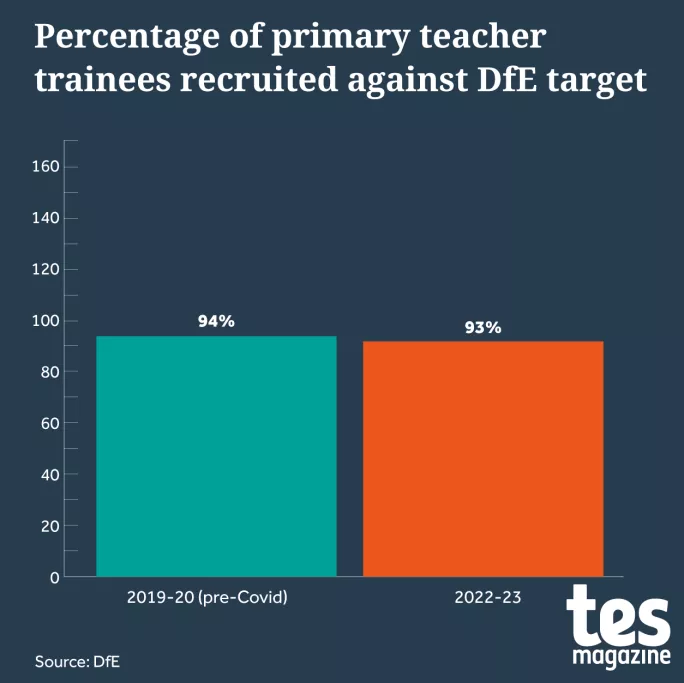
Previously, between 2014 and 2019, the number of primary trainees entering courses consistently met or exceeded the target deemed necessary.
Secondary target missed by a wider margin
In September DfE data showed that 12,490 initial teacher training (ITT) trainees had been placed on secondary courses for the 2022-23 academic year. This was 40.4 per cent below the 20,945 target.
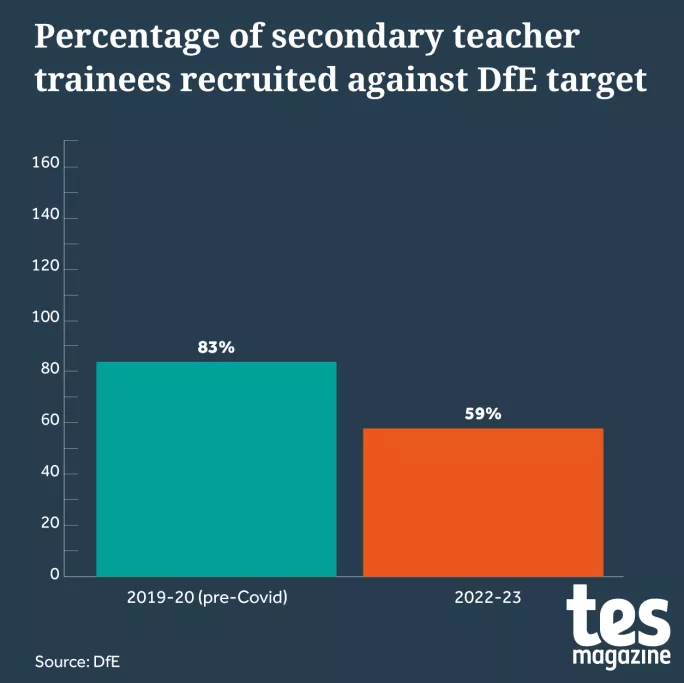
And this week’s data reveals that there were 12,356 ITT entrants at secondary level, just 59 per cent of the target.
While some subjects exceeded their targets at secondary, more than three-quarters failed to reach the numbers the DfE said were required.
North East sees greatest decline
The number of trainees recruited on to courses this year fell across all regions apart from London. The largest fall - of more than a third (37 per cent) - was in the North East when comparing the academic year 2022-23 with the last pre-pandemic intake for 2019-20.
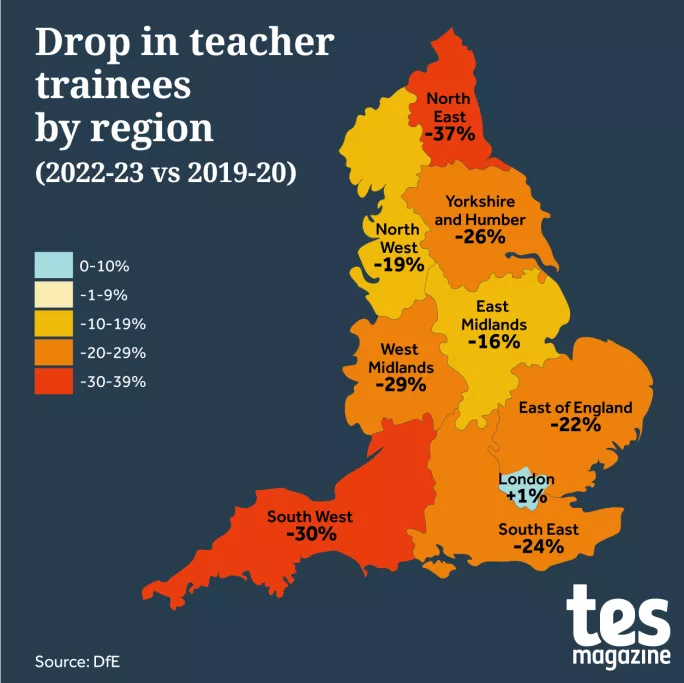
The other regions worst hit were the South West, which saw a decline of 30 per cent, the West Midlands (a 29 per cent fall) and Yorkshire and the Humber (down 26 per cent).
The only region that saw a rise in the number of ITT entrants this year compared with 2019 was London, which experienced a modest increase of 1 per cent.
- Background: DfE fails to hit primary teacher trainee target
- Teacher training: Secondary teacher trainees 40 per cent below government target
- Exclusive: Teacher trainee dropout warning amid costs crisis
- Training: DfE raises teacher training bursaries amid recruitment crisis
EBacc impact
The English Baccalaureate suite of subjects is made up of English language and literature, double science, maths, a humanities subject and a modern foreign language.
It was created as a performance measure in 2011 by the government to encourage schools to ensure more students study traditional academic subjects.
However, DfE data reveals that most of the subjects that can be taken to achieve the EBacc failed to reach their recruitment targets this year.
Overall, the number of ITT entrants missed the recruitment target for EBacc subjects by 38 per cent.
Earlier this year a report warned that the government’s EBacc subject target at GCSE is “done for” and “will be quietly phased out” because not enough students are studying a modern language for it to be met.
The subjects worst hit
The subjects hit with the worst shortfalls were physics, which saw less than one-fifth of the targeted number of trainees recruited on to courses this year (17 per cent); design and technology, which only managed a quarter of the required trainees (25 per cent); and computing, which attracted less than one-third of the trainees needed (30 per cent).

Modern foreign languages also saw a slump, with the number recruited on to courses only amounting to one-third of the target (34 per cent).
This was even lower than pre-pandemic levels. For the 2019-20 academic year, the DfE recorded that trainees starting courses amounted to 62 per cent of the target for ITT entrants for the subjects.
And in music, the DfE missed its target by over a third this year (it was 36 per cent below target).
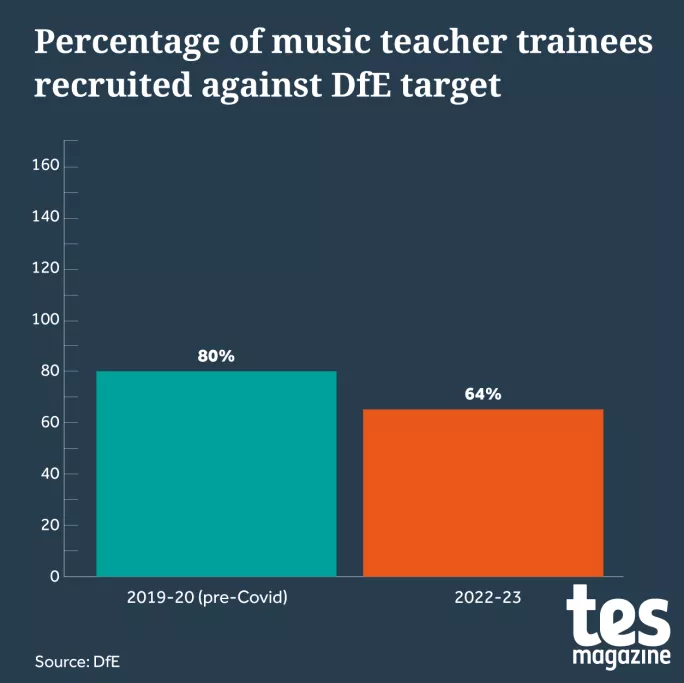
This was an increase on the shortfall of 20 per cent below target in 2019-20.
Just 54 per cent of the DfE’s recruitment target was achieved in science, technology, engineering and maths (Stem) subjects this year, with only 4,058 trainees starting on courses.

In 2019-20 the number of ITT entrants to Stem subjects made up 77 per cent of the DfE target.
The latest figures are despite the introduction of the Stem levelling up premium payment for early career teachers (ECTs) teaching mathematics, physics, chemistry and computing, in around 4,500 eligible state-funded secondary schools across England.
Furthermore, subjects such as English, which have historically been easier to recruit for, missed the target this year, with just 84 per cent of the number needed for the subject recruited.
This is in contrast to 2019, when 110 per cent of the trainees needed entered English ITT courses.
And in maths, while a larger percentage of the target was achieved than in 2019-20, entrants were still 10 per cent short of the DfE ambition.

In 2019-20 only 65 per cent of the ITT entrants needed were recorded.
The subjects that avoided the slump
But some subjects managed to exceed their targets, which could hide the larger shortfalls in secondary that are being shown overall.
In classics, 193 per cent of the trainee entrants required started on courses this year.
Drama exceeded its target, with 113 per cent of the trainees needed recruited, with a similar picture in history, where 133 per cent of the ITT recruitment target was achieved.
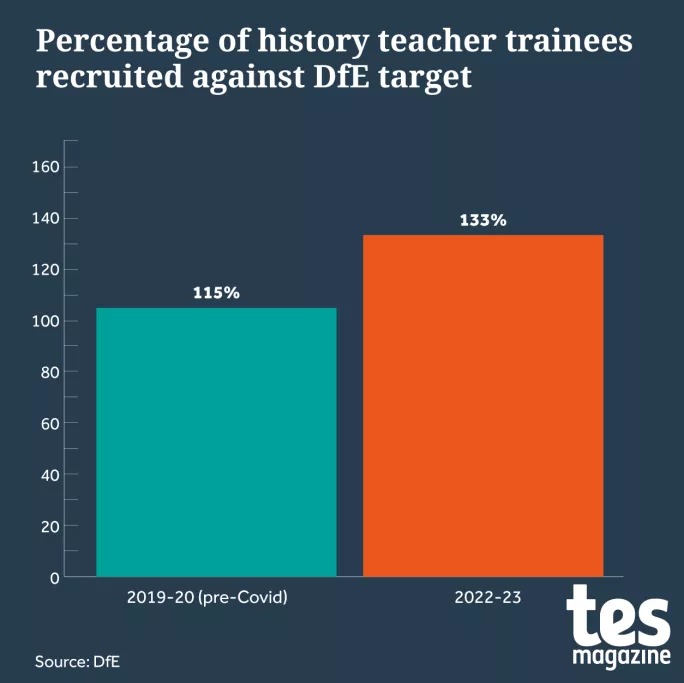
The gender split in ITT trainees
The number of male recruits for primary ITT continues to be overshadowed by the number of female recruits.
DfE data shows that 84 per cent of the ITT entrants to primary were female, compared with 16 per cent who were male.
At secondary, the split was slightly less exaggerated with a 61 per cent female to 39 per cent male ratio.
However, male ITT entrants did outstrip female candidates in physics (70 per cent to 30 per cent), with an increase compared with last year when the split was 67 per cent to 33 per cent.
Career changers fall
The proportion of postgraduate ITT entrants under the age of 25 has increased by 3 percentage points compared with pre-pandemic levels, suggesting the number of career changers entering teaching has fallen.
For the 2022-23 academic year, 53 per cent of ITT entrants were aged under 25, compared with 50 per cent in 2019-20.
One ITT provider director told Tes earlier this week that they had already seen a fall in trainees that have made career changes this year.
They suspect that more flexibility in other areas of work means “those people are no longer necessarily wanting to change their career, because they can keep their large salary and do their job at home”.
And living in more expensive areas might be putting potential applicants off the move to avoid a pay cut.
Writing yesterday, Professor John Howson, chairman of TeachVac, said the bursary scheme “isn’t working”.
He added: “Perhaps it is time to revert to offering a salary during training to all trainees, allowing them to build up pension credits and making career switching more attractive.”
You need a Tes subscription to read this article
Subscribe now to read this article and get other subscriber-only content:
- Unlimited access to all Tes magazine content
- Exclusive subscriber-only stories
- Award-winning email newsletters
Already a subscriber? Log in
You need a subscription to read this article
Subscribe now to read this article and get other subscriber-only content, including:
- Unlimited access to all Tes magazine content
- Exclusive subscriber-only stories
- Award-winning email newsletters
topics in this article



